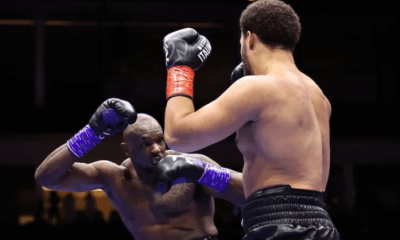Featured Articles
HOW HE DID IT: Underrated Technician Matthysse Not Just A Bomber
Lucas Matthysse (now 34-2 with 1 no contest and 32 Kos) showed why he is arguably the number one junior welterweight in the world –and one of the most avoided men in boxing –with an impressive third round knockout of Lamont Peterson (now 31-2-1 with 16 Kos) in Atlantic City on Saturday night.
Peterson, who had never been stopped in any of his previous 33 fights, was dropped by a left hook in the second round and again in the third. After tasting the canvas once more from yet another left hook, referee Steve Smoger deemed Peterson unfit to continue and wisely called a halt to the action. This is now the sixth fight in a row in which Matthysse has managed to take his opponent out before the final bell.
Everyone and their mother knows that Lucas Matthysse is the owner of some extremely heavy hands, making him pound-for-pound one of the hardest hitters in all of boxing. In this analysis, however, I would like to focus more on Matthysse’s craft and ring acumen, which, I believe, are vastly underappreciated and can be attributed toward many of his knockouts.
It was obvious from the opening bell that Peterson’s game plan was based on controlling and maintaining distance and preventing Matthysse from getting set to hit. For Peterson to have had any kind of success then, he would have had to rely heavily on the jab (boxing’s number one distance regulator) along with lateral movement so that Matthysse would have to keep realigning himself in order to punch effectively and with maximum power. It soon became apparent that neither Peterson’s jab nor any lateral movement were going to be enough to thwart Matthysse’s forward momentum.
Not only did Matthysse successfully block off Peterson’s escape routes via some intelligent footwork and pressure, he also neutralized Peterson’s jab.
It is very important for a fighter to have a varied attack. However, it is equally important that a fighter also has more than one way of defending an attack. Just as a fighter will soon recognize an offensive pattern should an opponent repeat the same technique over and over, a fighter will also be quick to spot and take advantage of an opponent who defends an attack the same way every time. Because Matthysse changed up his defenses for Peterson’s jab throughout the fight, Peterson was unable to time him or lure him into any kind of a trap.
Rear hand parry
Instead of just simply covering up, a skill that all fighters should utilize more often is the rear hand parry to catch and deflect an incoming jab. When attempting to parry the jab, the hand that is on the outside of the attack (elbow side of an opponent’s punch) should redirect the blow either across an opponent’s body, up and over, or down and to the side. Unless a fighter is going up against an opponent who is in an opposite lead to their own, it is not advisable to parry an incoming jab with the lead hand as doing so will leave the lead side exposed for an opponent’s more threatening rear hand. Parrying the jab with the rear hand disturbs an opponent’s rhythm, making it more difficult for them to complete or launch a follow up attack and also creates counterpunching opportunities, particularly for the lead hand (catch and jab).

Here is Matthysse performing a rear hand parry, catching and redirecting Peterson’s jab at different stages during the fight.
Outside Slip
The outside slip is probably the safest and most efficient way of avoiding the jab. Whereas the rear hand parry often only leaves the lead hand free to counter with (one can also counter immediately after a rear hand parry with the same hand but it is often more difficult to pull off) slipping to the outside of the jab (elbow side) isolates both of an opponent’s weapons (lead and rear hand) while leaving both hands free to counter with.

Here is Matthysse evading Peterson’s jab by slipping to the outside. In this position, Matthysse has isolated both of Peterson’s weapons (lead and rear hand) leaving both hands free to counter with.
Inside slip
The inside slip is performed much in the same way as the outside slip, only the head is taken to the inside of an opponent’s jab instead of to the outside. Even though both hands remain free to counter in this position as well, the outside slip is preferred and is a much safer option. Still, Matthysse had a lot success by slipping inside of Peterson’s jab.

Here is Matthysse slipping inside of Peterson’s jab at numerous stages during the fight. For safety reasons, it is better to slip to the outside of a jab, as opposed to the inside. When you slip to the outside, you are basically isolating both of your opponent’s weapons (lead and rear hand). Slipping inside of the jab, however, is considered more dangerous because only the jabbing hand has been isolated and the danger of an opponent’s rear hand is still present. Matthysse got away with slipping inside of Peterson’s jab simply because Peterson was always preoccupied with the threat of Matthysse’s left hook. Despite the fact that Matthysse would often take his head off line and place it in line with Peterson’s right hand, the threat alone of Matthysse’s left hand kept Peterson’s right hand in check.
Defense is taken to a new level entirely when a fighter begins using it offensively. After pretty much eliminating Peterson’s jab with the rear hand parry, the outside slip and the inside slip, Matthysse began simultaneously slipping and countering off of Peterson’s jab.
For a right handed fighter, the body alignment involved in slipping inside the jab is very similar to the starting motions of a right cross. Therefore, slipping inside the jab and throwing the right cross (to the head or body) is a safe and effective counter.

Here is Matthysse simultaneously slipping inside of Peterson’s jab and landing a right hand underneath. See how the inside slip places Matthysse in a relatively safe position from which to deliver the right hand. Notice also how Matthysse’s head has been taken off line as he’s throwing his right hand. Slipping left while throwing a right cross is an intelligent pre-emptive counter to lead off with.
Here is another example of Matthysse combining defense and offense simultaneously.

Here, Matthysse lands a cross counter over the top of Peterson’s jab. Because most fighters aim there punches directly toward an opponent’s center, by taking his head off line and to his left, Matthysse lands his right hand (this punch initiated the first knockdown sequence) while Peterson’s jab misses and ends up somewhere near Matthysse’s right shoulder.
The set up
There’s no denying that Lucas Matthysse is one of the biggest punchers in the sport right now. Even glancing blows seem to put his opponents on Queer Street. However, all the knockout power in the world will amount to nothing unless a fighter can set an opponent up and disguise his real intentions. (Nonito Donaire found this out the hard way against Guillermo Rigondeaux very recently). In boxing, basic punches will not land with any regularity unless a fighter can do something which makes an opponent open up (feinting, drawing, pivoting to gain a dominant angle etc.). For me, this is one of the most overlooked aspects of Lucas Matthysse’s game. Matthysse is brilliant at maneuvering his opponents into such a position –using low contact punches, feints and footwork—so to create an opening for a more telling blow.
Here is Matthysse manipulating Peterson’s guard and defenses by throwing not one, not two, but THREE (double jab, straight right) punches in an attempt to create an opening for his left hook.

Here is Matthysse throwing three “minor” punches in order to set up one “major” blow. As Matthysse shuffles forward after cutting off the ring, forcing Peterson to the ropes, he throws two blinding jabs (jab feints) to occupy Peterson. While the first jab is thrown short (as a distraction) the second one is thrown much deeper, allowing Matthysse to move in behind it and bridge the gap. From there, with Peterson’s guard slightly raised because of the double jab, Matthysse throws a straight right hand to Peterson’s stomach. This does two things;
- It positions Matthysse at a more favorable angle to come back with a left hook (spring-loaded his left).
- It forces Peterson to adjust his guard slightly to compensate for the body attack.
With Peterson hunching over slightly in anticipation of another possible body attack, Matthysse lands a left hook high on Peterson’s head, sending him to the canvas. Peterson never fully recovered from this attack.
Barely seconds into third round, there was more punching intellect from Matthysse.

During this sequence, Matthysse first slips inside of Peterson’s jab. As Peterson ducks low in response, Matthysse forces him onto his back foot with a blinding jab. With Peterson backpedalling, Matthysse feints a right hand, which draws Peterson’s lead hand away from his guard, and comes back with a hard left. Again, Matthysse is thinking two and three punches ahead in there.
With Peterson wobbled again, we didn’t have to wait too long before the end arrived.

As both men find themselves slightly out of position, Matthysse is the first to adjust his feet and manages to connect with a compact left hook to the chin, all but ending the fight for Peterson. Although Peterson made it to his feet, his legs were gone and he soon he hit the canvas for a final time after yet another left hook.
At this juncture, I’m hard pushed to think of anyone at 140 pounds that I would favor over Matthysse. Amir Khan certainly has the speed and footwork that may keep Matthysse turning and prevent him from getting set to hit, but ultimately, Khan’s defensive frailties are bound to rear their ugly head at some stage, meaning he would more than likely succumb to Matthysse’s unforgiving power punching. Danny Garcia is a smart counterpuncher with good timing who could possibly hurt Matthysse should he get to him first, but looking at how Zab Judah was able to withstand Garcia’s best and then hurt Garcia himself late in the fight, I have a hard time seeing Garcia coming out on top during any kind of exchange with Matthysse. As I’ve already stated, not only does Matthysse have underrated defense (slipping, parrying etc.), he also has a world class chin –Peterson landed a couple of uppercuts as he was moving inside that would have wobbled many a Jr. welterweight. Matthysse never so much as blinked.
All things considered, it was quite the eye opening performance from Lucas Matthysse –out boxing Peterson from the outside and out fighting him on the inside. Matthysse is not only one of the most damaging punchers currently in boxing, but with his ring intelligence and punch placement, he is also one of the most cerebral. Unlike some punchers who are head over heels in love with their power and aim everything at the head, Matthysse will patiently work the body for a period of time (usually behind straight rights and low jabs), bringing down his opponent’s guard before taking the attack up top. And when he is attacking up top, he is always mixing up straight punches with arcing punches, constantly forcing his opponents to narrow and widen their guard to compensate. Add to this the fact that he almost always takes his head off line while he is punching, and you have a very complete and dangerous fighter indeed.
-

 Featured Articles4 weeks ago
Featured Articles4 weeks agoThe Hauser Report: Zayas-Garcia, Pacquiao, Usyk, and the NYSAC
-

 Featured Articles3 weeks ago
Featured Articles3 weeks agoOscar Duarte and Regis Prograis Prevail on an Action-Packed Fight Card in Chicago
-

 Featured Articles2 weeks ago
Featured Articles2 weeks agoThe Hauser Report: Cinematic and Literary Notes
-

 Book Review2 weeks ago
Book Review2 weeks agoMark Kriegel’s New Book About Mike Tyson is a Must-Read
-

 Featured Articles4 weeks ago
Featured Articles4 weeks agoRemembering Dwight Muhammad Qawi (1953-2025) and his Triumphant Return to Prison
-

 Featured Articles7 days ago
Featured Articles7 days agoMoses Itauma Continues his Rapid Rise; Steamrolls Dillian Whyte in Riyadh
-

 Featured Articles3 weeks ago
Featured Articles3 weeks agoRahaman Ali (1943-2025)
-

 Featured Articles3 weeks ago
Featured Articles3 weeks agoTop Rank Boxing is in Limbo, but that Hasn’t Benched Robert Garcia’s Up-and-Comers













